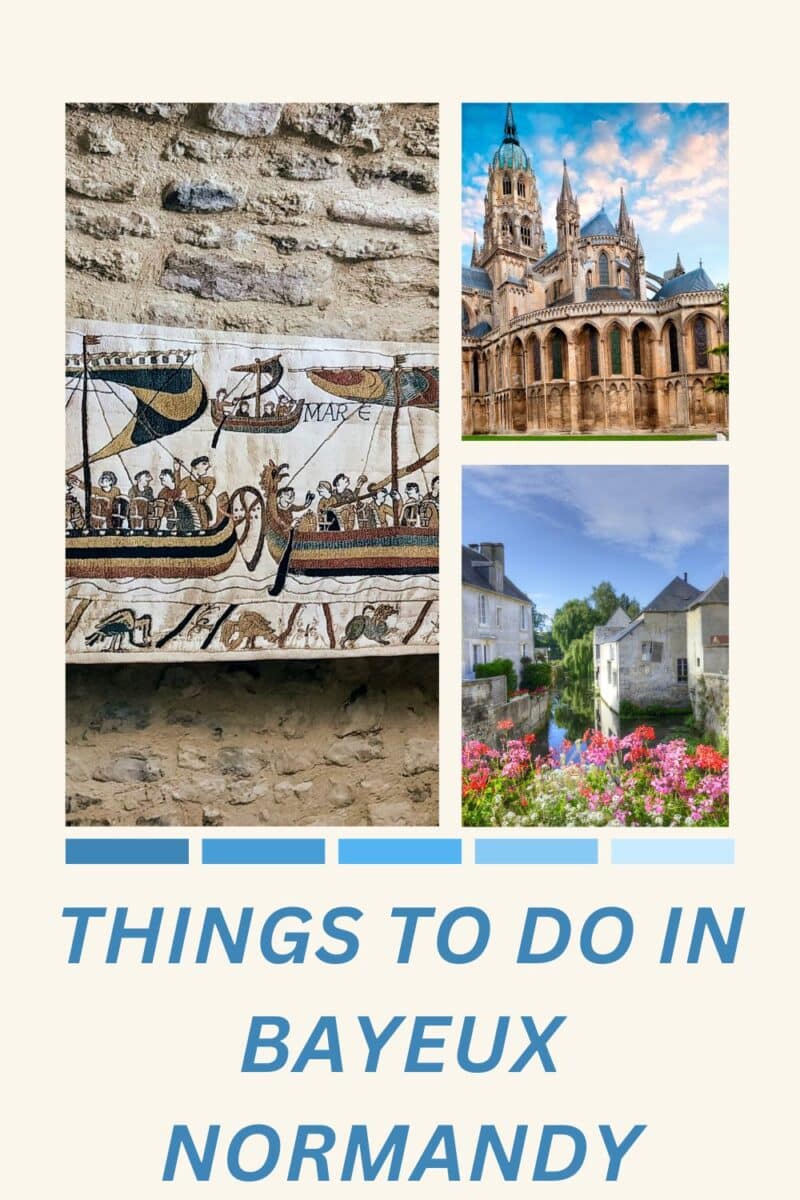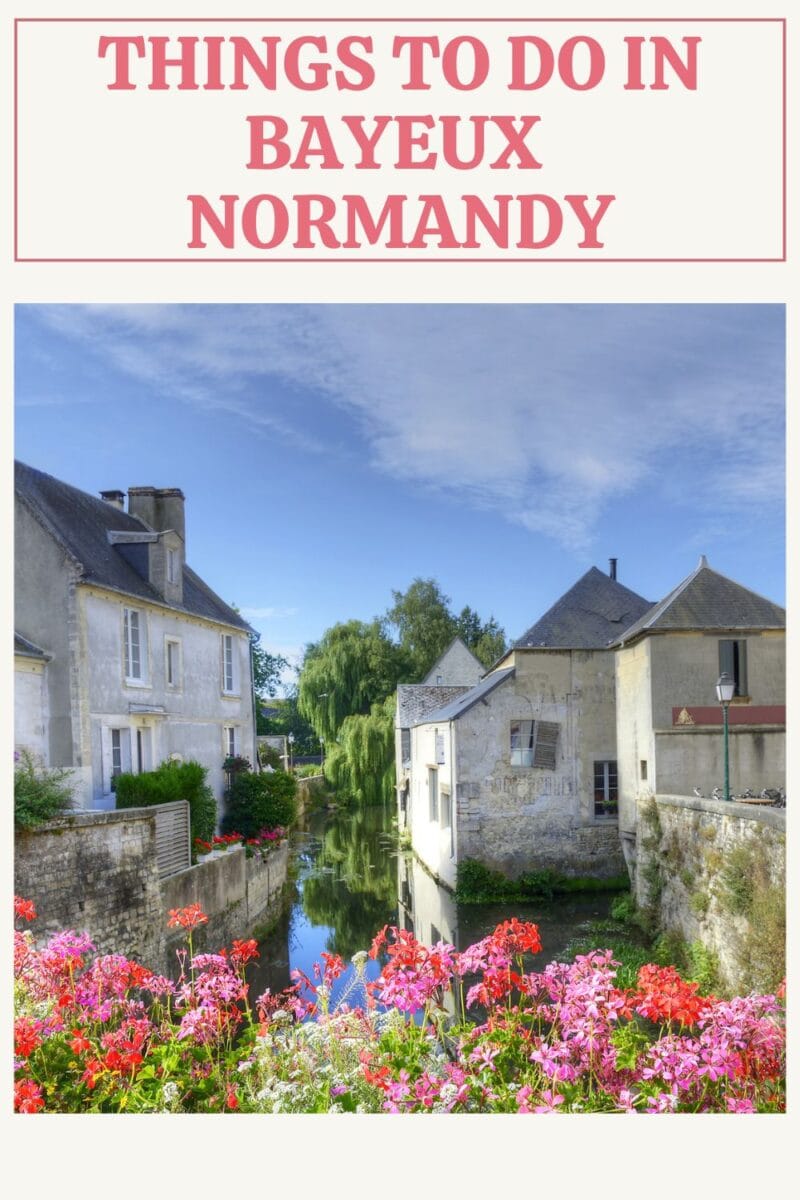Visiting Bayeux France: things to do in Bayeux Normandy 2024
I have always dreamt of visiting the famous French tapestry known as the Bayeux Tapestry and when the opportunity came up to spend a few days in Bayeux France I was overjoyed. As it turns out I have to say that Bayeux is one of my favourite places in Normandy.
Bayeux is one of many small towns in France, easily walkable with some phenomenal restaurants and with its proximity to the Normandy beaches and the coastline of Normandy it makes the perfect place to stay while exploring this area of France.
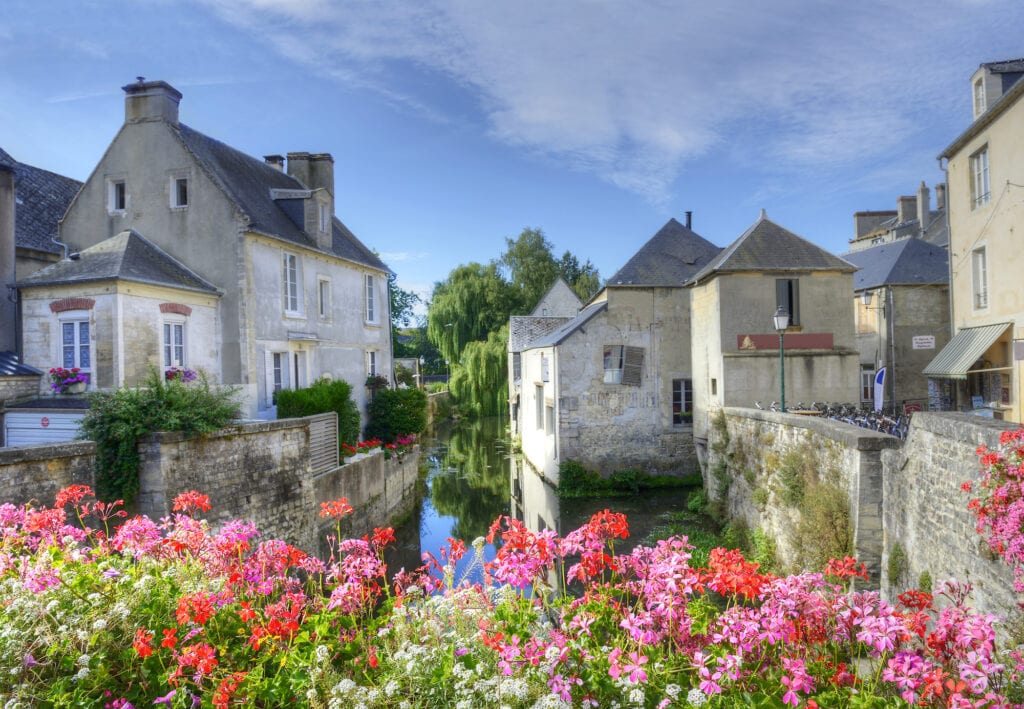
In the main tourist months, you will meet literally hundreds of American tourists visiting the memorials of WWII and walking the beaches of Normandy. From Omaha Beach to Utah, Gold, Swords and Juno Beach the area is dedicated to those brave souls who landed on the beaches to defeat the Germans and the push to take England.
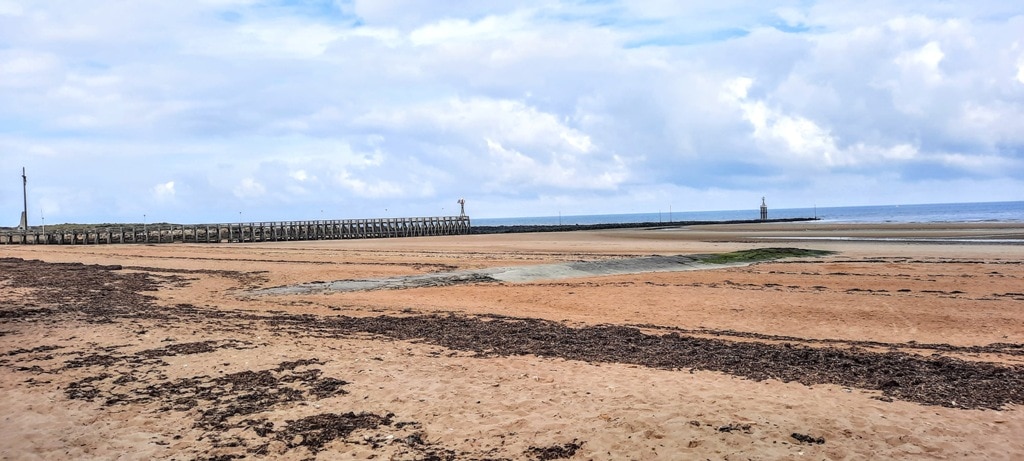
- Visiting Bayeux France: things to do in Bayeux Normandy 2024
- FAQ – Things to Do in Bayeux Normandy
- What are the top attractions in Bayeux Normandy?
- How can I explore the D-Day sites in Bayeux?
- What is the significance of Bayeux Cathedral?
- Where can I find the best cider in Bayeux?
- What are some recommended museums to visit in Bayeux?
- Is Bayeux suitable for a guided tour?
- What is Bayeux famous for?
- How to you pronounce Bayeux?
- When does the Bayeux Cathedral Light show happen?
- When is the Bayeux Medieval Festival?
- How far is Bayeux from Paris?
- Is Bayeux worth visiting?
- How to get to Bayeux France
- History of Bayeux
- Things to do in Bayeux – all the best places and Bayeux attractions to see
- Battle of Normandy
- What is the Bayeux Tapestry? Bayeux Tapestry visit
- Shopping in Bayeux, france
- D Day Beaches and Museums from Bayeux
- Where to eat in Bayeux, France
- Where to stay in Bayeux, France
- FAQ – Things to Do in Bayeux Normandy
Xyuandbeyond is reader-supported. When you buy through links on our site, we may earn an affiliate commission. You can read my privacy policy here.
FAQ – Things to Do in Bayeux Normandy
What are the top attractions in Bayeux Normandy?
Bayeux, located in Normandy, France, offers a rich tapestry of attractions including the famous Bayeux Tapestry, Bayeux Cathedral, Museum, and historical sites related to the Battle of Normandy and D-Day.
How can I explore the D-Day sites in Bayeux?
Exploring the D-Day sites in and around Bayeux can be done through day tours that take you to significant locations like Omaha Beach, Pointe du Hoc, Utah Beach, the American Cemetery, and Arromanches.
What is the significance of Bayeux Cathedral?
Bayeux Cathedral is a stunning Gothic masterpiece that houses the tomb of William the Conqueror and offers visitors a glimpse into medieval architecture and history.
Where can I find the best cider in Bayeux?
Bayeux and the surrounding Normandy region are renowned for their delicious cider production, offering visitors a chance to taste authentic Calvados and other apple-based drinks.
What are some recommended museums to visit in Bayeux?
Bayeux boasts several museums such as the War Cemetery, D-Day Museum, and Bayeux Museum, all of which provide insights into the region’s rich history and culture.
Is Bayeux suitable for a guided tour?
Bayeux is perfect for guided tours that offer in-depth explorations of its attractions, including the famous Bayeux Tapestry, Cathedral, and other notable
What is Bayeux famous for?
The world-famous, UNESCO-listed tapestry depicting the Norman conquest of England in 1066.
How to you pronounce Bayeux?
Bayeux pronunciation – for those of us who don’t speak French Bayeux is pronounced as bay-yu.
When does the Bayeux Cathedral Light show happen?
From mid-July till the end of August each year (“Tree of Liberty” and highlighting of the cathedral) in the evening. Rendez-Vous à la Cathédrale” takes place at the foot of the Tree of Liberty with a 360° light show projected onto the trunk of the huge plane tree, honouring life and liberty in a series of musical scenes.
When is the Bayeux Medieval Festival?
The magnificent Medieval Festival enlivens Bayeux for the first weekend in July every year and has done so for 3O years, attracting some 50,000 people to the city.
How far is Bayeux from Paris?
It is around a 3-hour drive from Paris and there are 8 direct trains a day to Bayeux.
Is Bayeux worth visiting?
Absolutely I can’t recommend a visit to Bayeux any higher. It is the perfect place to stay if visiting the Normandy beaches, for foodies there is plenty of wonderful choices, and of the Bayeux Tapestry and Cathedral.
How to get to Bayeux France
How to get to Bayeux from Paris?
If you are spending a few days in Paris before seeing more of France the easiest way to reach is by train, bus or car. There is a direct train from Paris to Bayeux. The journey is just under two hours and 20 minutes, and it leaves from the Paris St-Lazare train station.
You can get to Bayeux from Paris by bus this is usually cheaper than the train but much longer. I would recommend booking your train tickets well in advance of your journey as the cost will be much cheaper.
Paris to Bayeux by Car
We drove to Bayeux from Dinan which was an easy journey. If you are renting a car and driving from Paris the trip will take around 3 hours. I would be inclined to take 2 days to drive from Paris and see Versailles and Giverny along the way – each of which will take the good part of a day if not longer. Many of the hotels and accommodations in Bayeux have parking but I must admit we didn’t have a problem finding parking in the town.
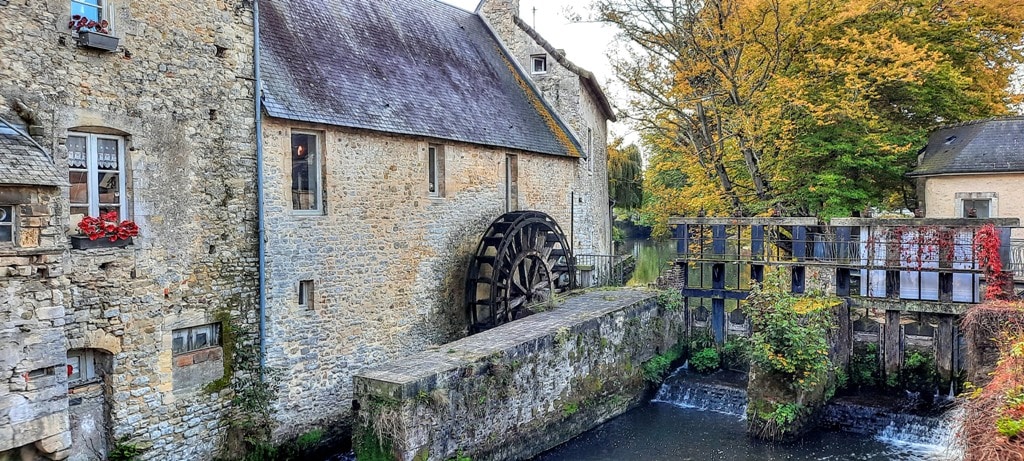
History of Bayeux
Two important historical conquests directly affected Bayeux, one nearly 1,000 years ago, and another just in the last century.
Norman Conquest of England in 1066
The first was the Norman conquest of England led by William the Conqueror in 1066, depicted in the Bayeux Tapestry. William, Duke of Normandy, invaded England and defeated English King Harold at the Battle of Hastings on the south coast of England. He was crowned king in Westminster Abbey on Christmas Day, 1066, marking the beginning of a period of Norman rule in England that lasted about 100 years.
In 1990 archaeologists discovered that the huge blocks in the base of the cathedral indicated the presence of an old Roman building. By the 3rd century, Bayeux had a wall around the city but it was torn down in the 18th century. As it was a very important location Bayeux was the first line of defence of the Roman Empire against the Viking invaders.
Bayeux was largely destroyed during the Viking raids of the late 9th century but was rebuilt in the early 10th century but came under the rule of Hagrold a Viking who defended the city against the Franks.
In the year 911, by the treaty of Saint-Clair-sur-Epte, King of the Franks, conceded to Rollo the Viking all his lands ‘from the Epte to the sea’ which of course included Bayeux.

Decades later the Normans (aka Vikings with a name change) reorganised their conquered terrain. The inheritance of Normandy would be passed onto William the Conqueror, who was born in Falaise. In 1066, the Duke, by the trial of battle at Hastings, would become King of England. The story is told in stunning detail in the Bayeux Tapestry.
The Bayeux Cathedral was also the location for the oath taken by Harold II that he would marry the Conquer’s daughter which would give William a better chance of taking the crown of England.
Harold had apparently accompanied William to battle against William’s enemy Duke Conan II of Brittany. Harold pursued Conan past the abbey of Mont Saint-Michel, onto Rennes, and finally to Dinan, where he surrendered the fortress’s keys at the point of a lance. William presented Harold with weapons and arms, knighting him.
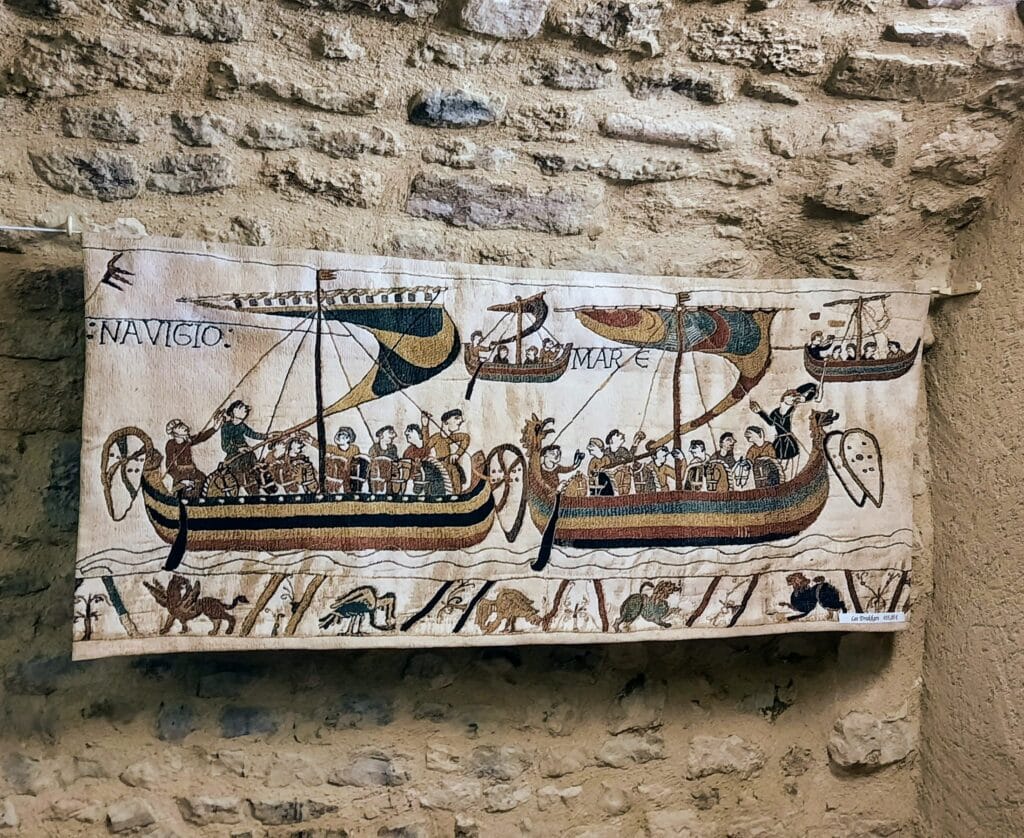
The Bayeux Tapestry records that Harold swore an oath on sacred relics to William to support his claim to the English throne. After Edward’s death, the Normans were quick to point out that in accepting the crown of England, Harold had broken his oath and this led to the Battle of Hastings.
Richard the Lionheart, was the great-great-grandson of William the Conqueror, and he ruled the area as king for 10 years his violent and untimely death was to lead to Normandy’s annexation to France.
Bayeux France WW2
The Nazis left Bayeux on 6 June 1944 and the Resistance quickly informed the Allies that the Germans had left Bayeux and that there was no point in bombing the town and so Bayeux was spared that devastation.
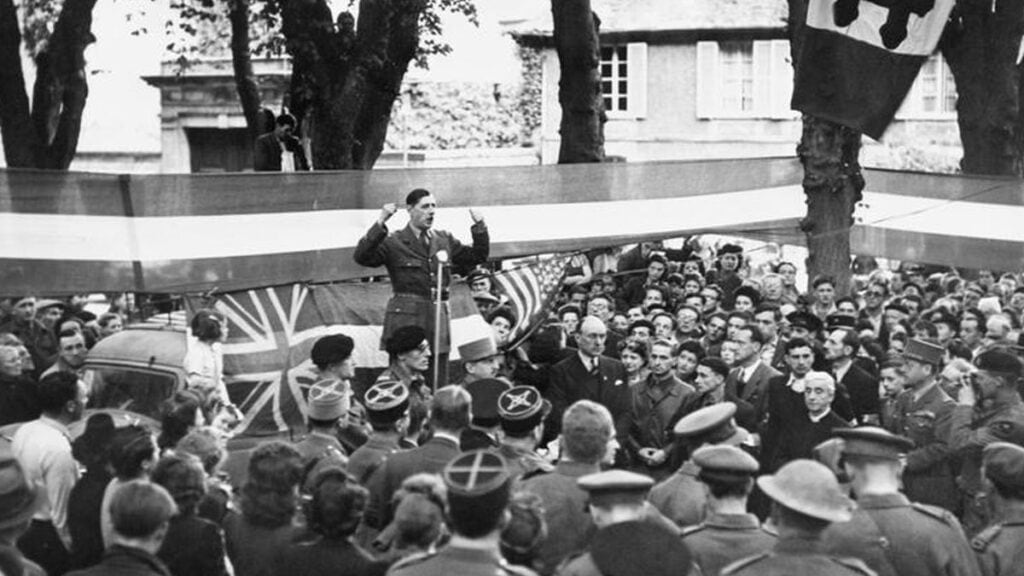
But with its proximity to the Landing beaches, Bayeux became a transit hub for both soldiers and civilians. The town was strategically positioned for the Allies with thousands of soldiers and vehicles passing through on their way to the combat zones. But their machines could not get through the narrow streets of the medieval city so the Allied engineering units built a road around the town – known as the Bypass.

On 14 June 1944, General De Gaulle landed in Normandy and went straight to Bayeux where he gave his first speech on French soil. The enthusiastic reception from the crowd of citizens served to demonstrate De Gaulle’s legitimacy in the eyes of the Allies as the leader of liberated France. In the summer of 1944, Bayeux became the French capital until Paris was liberated on 25 August.
Things to do in Bayeux – all the best places and Bayeux attractions to see
Battle of Normandy
The beaches of Normandy and the D-Day sites are located to the north of Bayeux. Bayeux is situated approximately 10 kilometers (6 miles) inland from the coast. The D-Day landing beaches, such as Omaha and Gold, are easily accessible as day tours from Bayeux, making the town a central point for visitors looking to explore these significant sites.

On June 6, 1944, known as D-Day, Allied forces launched a massive invasion on these shores, (known now as the D-Day Beaches) marking a pivotal turn in the war against Nazi Germany. The five beaches—Utah, Omaha, Gold, Juno, and Sword—each saw intense fighting and incredible acts of bravery.
You can also head to Pointe du Hoc famous for its prominent cliff-top location situated between Utah Beach and Omaha Beach. It holds historical significance due to its role in the D-Day invasion of World War II on June 6, 1944. The site was a heavily fortified German position, equipped with artillery that could threaten both landing beaches.
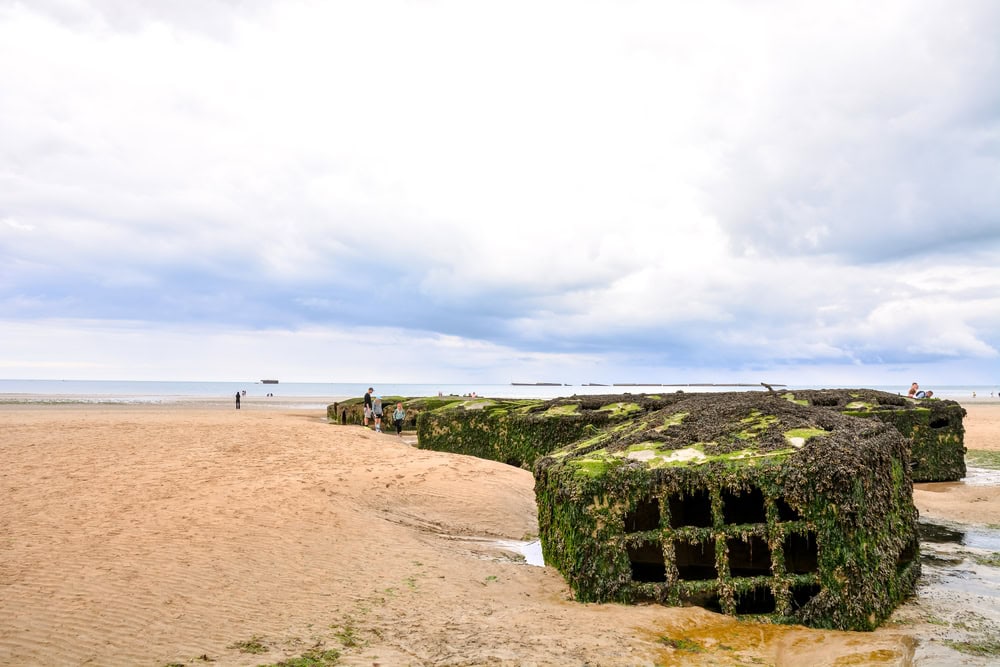
Arromanches, also known as Arromanches-les-Bains, can also be reached from Bayeux it is renowned for its pivotal role during the D-Day invasion of World War II. On June 6, 1944, this site became crucial for the Allies as they established a temporary artificial port, known as Mulberry Harbour. The remains of the Mulberry Harbour can still be seen today. Arromanches also features the D-Day Museum, which provides insights into the historical significance of the area and the monumental events of D-Day.
Guided Walking Tours of Bayeux
Bayeux Discovery Walks offers walking tours of medieval Bayeux in English starting from the tourist office every day at 9.30 am. They also offer walks at 5.00 pm from April through September. The cost is 15€ per person for a 2-hour tour.

Memorial Museum of the Battle of Normandy
On the outskirts of the town, you will find the Memorial Museum of the Battle of Normandy which documents everything related to the Normandy Invasion or D-Day. Canadian, British and American soldiers arrived on the nearby beaches and fought in horrific conditions against the German occupiers and Bayeux was the first town to be liberated.
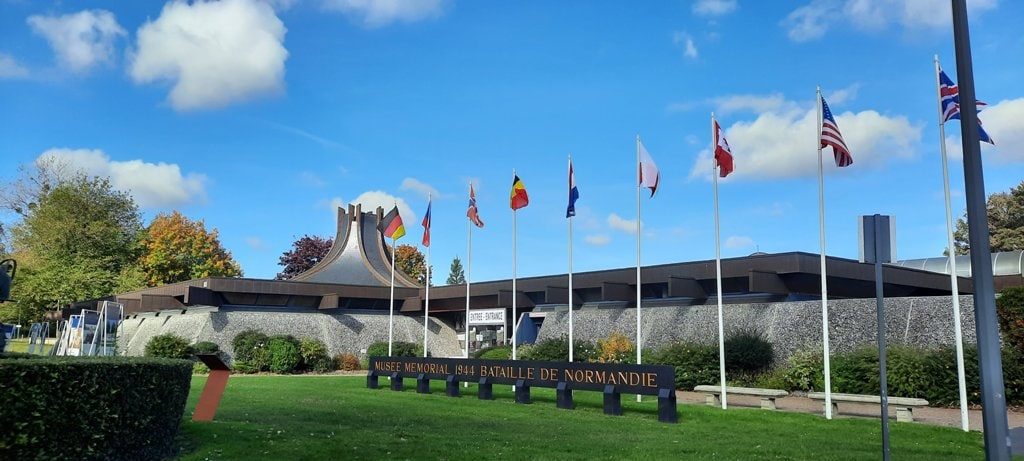
Considered one of the best in the world this D-Day Museum in Bayeux displays include military equipment, such as fighter tanks and smaller arms used and dioramas depicting conditions and actions of the war.
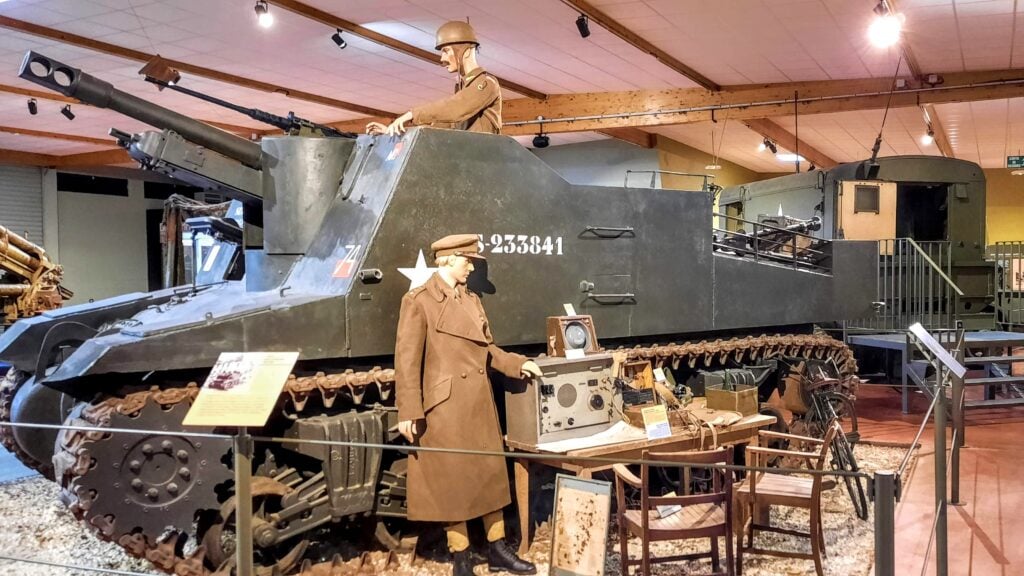
The Bayeux War Cemetery
A beautifully maintained graveyard with about 4,500 graves is just down the road from the Museum and is worth a visit to pay your respects to the fallen soldiers. It will break your heart to see the ages listed on the many gravestones, you can also check for your fallen family members in the book of names kept in the Memorial.

We purchased a Bayeux Museum Pass which gave us entry to 3 of the areas finest museums. The Battle of Normandy (Bataille de Normandie), Bayeux Tapestry (La Tapisseries de Bayeux, and the MAHB Baron Gerard Art and History Museum.
The Bayeux museum pass cost 15€ euros each, well worth the money.
Walking the town of Bayeux
Bayeux is a charming town with the River Aure flowing through it and several picturesque watermills to enjoy. Bayeux was also one of the first towns to be liberated by the Americans and anyone from North America will get a very warm welcome.
You can take walking tours or a small touring train around Bayeux which start at the Tourist Office on Rue Saint-Jean.

The town square is a pretty spot with a fountain in the middle and several historical plaques. It was here that Charles de Gaulle spoke a week after the British, American and Canadian forces entered Bayeux on June 14, 1944.
Bayeux was miraculously preserved from the bombings of 1944 during the World War II Allied invasion of Normandy and as a result, some of its significant buildings were fortunately preserved.
Cathedral of Our Lady of Bayeux
Set in the heart of Bayeux and fortunately for us just across the street from our BnB the Notre Dame Cathedral’s construction was originally built in a Romanesque style in the 11th century. It wasn’t until the 15th century that gothic features were added to the building.

Notre Dame Cathedral de Bayeux is over 900 years old and has survived countless wars over hundreds of years. The Cathedral is the centrepiece of this pretty town and the spire can be seen from anywhere in town. At night the Cathedral glows golden in the spotlight.
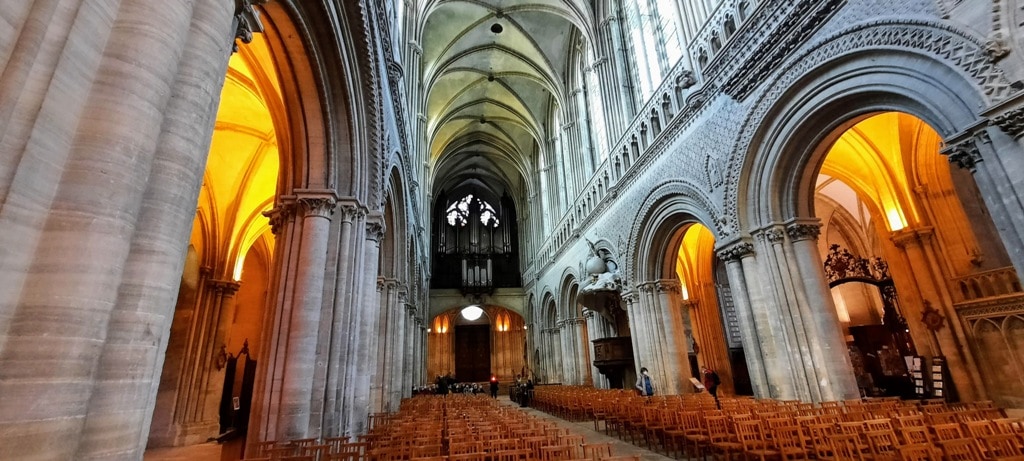
The intricate gothic exterior with its soaring arches and exquisite stained glass windows is breathtaking. Make sure you visit the crypt with its ancient paintings. There is also a really pretty little courtyard next to the cathedral with a tree that is said to be hundreds of years old.

If you are visiting in November and December make sure to take in the Tapestry of Bayeux light show on Saturday nights. A 30-minute digital show that brings the famous tapestry to life it’s free.
Conservatoire de la Dentelle
Dating back to the 17th century two nuns were brought to Bayeux from Rouen to assist the Bishop of Bayeux in his offices. The nuns shared the art of lacemaking with the women of Bayeux and the Conservatoire maintains the tradition. You can take classes at the Conservatory while in Bayeux.
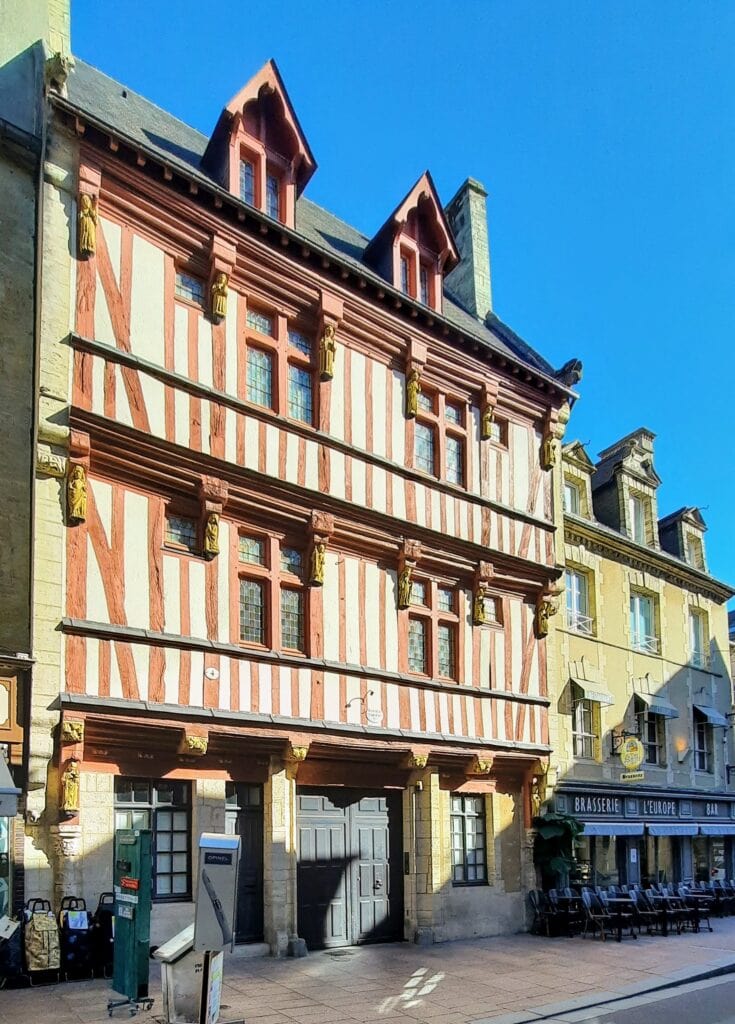
What is the Bayeux Tapestry? Bayeux Tapestry visit
Bayeux Tapestry FAQS
What is Bayeux France known for? Bayeux France is known for the Bayeux Tapestry.
Where is Bayeux Tapestry in France? It is located in the Bayeux Tapestry Museum in the heart of Bayeux across from the Cathedral.
Why is the Bayeux Tapestry in France? The Bayeux Tapestry has resided in France for its entire 950-year history and is on permanent display in the town of Bayeux in Normandy. The reason the tapestry resides in France is likely because Normandy holds its history very dear to the people of the region.
How much does it cost to see the Bayeux tapestry? When you visit the Bayeux Tapestry Museum, the cost of an admission ticket is 12€ per adult in 2022, 5€ for children over 10 and students. The ticket includes the use of an audio guide with an offer of 16 languages, which explains the scenes on the Bayeux Tapestry in about 25 minutes.
What are the Bayeux tapestry museum hours? The Museum of the Bayeux Tapestry is open to the public 7/7 days from February 1st to December 31st. Please buy your tickets at the museums, no tickets online or in advance.
The breathtaking Tapestry of Bayeux is a 68-meter-long embroidered cloth that tells the story of William the Conqueror and King Harold’s battle for the throne of England that ultimately led to the Battle of Hastings and the Norman conquest of England in 1066. The battle began because King Harold reneged on his promise to William to not take the throne of England following the death of King Edward.

Historians have various theories of who created the tapestry, but nearly all agree it was created shortly after the conquest. Legends say that the wife of William the Conqueror, Reine Mathilde and her ladies-in-waiting made the tapestry. Another legend says that it was designed and made by nuns in England.
Whoever embroidered the tapestry it is agreed that it was the same group of women that worked on the piece. In 2007 the tapestry was included in the UNESCO Memory of the World Register.

To preserve the tapestry it is hung in a dim room with lighting that won’t damage the fine linen and wool threads. There are no photos allowed of the tapestry. The tapestry which is really a hand-stitched embroidery using naturally dyed wood yarn is an incredible 68 metres long.
The 58 scenes pictured on the tapestry depict the events leading up to the Battle of Hastings in 1066 and the Norman conquest of England. The tapestry is an incredible nine centuries old. There are no photos allowed of the tapestry and the visit takes around 25 minutes to see the tapestry in all its glory
On the second floor of the Bayeux Tapestry Museum, you will find a replica of a Viking ship and other items depicting life in those times.
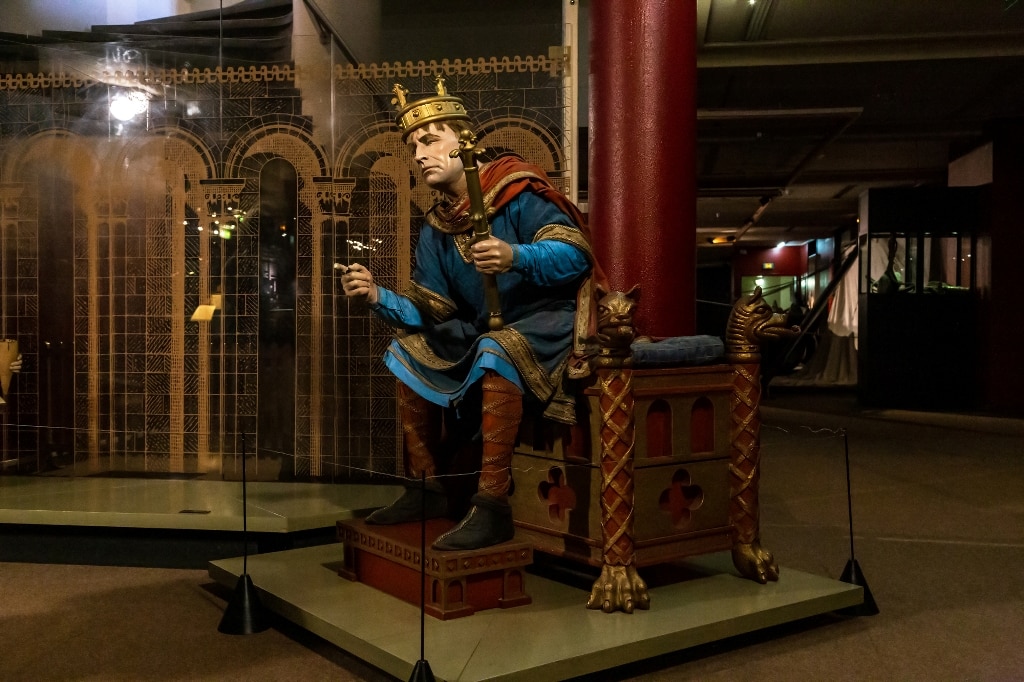
During WWII the Nazis became obsessed with stealing the tapestry and it was Himmler who believed the tapestry portrayed German origins. Himmler had the tapestry moved to the Louvre in Paris and had plans to move it to Germany. This plan was met by a strong French Resistance and it was kept in Paris to maintain its safety. After the the Tapestry was returned to Bayeux.
Bayeux Museum
This is a newer museum where you will find relics relating to Bayeux. From the prehistoric remains discovered in the area to paintings, sculptures, lace and porcelain. The Museum is located within a restored chapel.
Baron Gérard Museum
Included in the Museum pass the Baron Gérard Museum is located in the former Episcopal Palace of the Bishop of Bayeux. The building was closed in 2001 and recently reopened to the public in 2013. The Museum has an incredible collection of archaeological finds from the area along with displays of Bayeux lace and porcelain, there are also some fine paintings included in the collection from Boudin, Corot, Boucher and more.

The Botanical Gardens of Bayeux
The Gardens date back to the 19th century and are considered a Historical Monument of France. They span 6 acres and were designed by the famous French horticulturalists the Buhler brothers. The brother also designed the Parc du Thabor in Rennes.
Bayeux Market
Every Saturday morning virtually the whole town of Bayeux shows up for the weekly market in Saint Patrice square. Here you will find anything your heart desires from dozens of varieties of garlic to locally grown fresh seasonal vegetables, beds, clothing and Normany terroir products like Calvados, ciders, and lovely cheese. Bayeux Saturday market hours are usually from 8 am until 2. Also, in the summer there’s a Norman arts and crafts and local foods market on Thursday evenings in front of the town hall.

Shopping in Bayeux, france
Bayeux is not a big town and the shopping area is really two streets the Rue Saint-Martin and the Rue St. Malo in old town Bayeux. The shops are for the most part small and expensive but there are a few tourist-type shops for picking up souvenirs. The area also has many restaurants and cafes you can stop and take a break at.
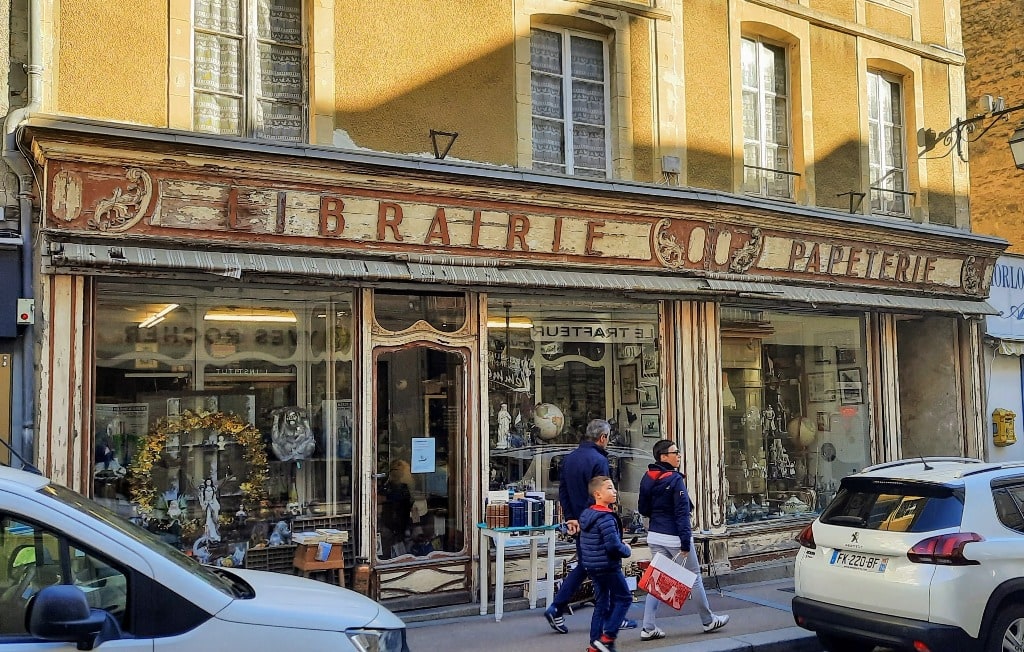
You will see lots of tabacs where you can rest your feet and have a coffee, beer or wine and just watch the people and traffic go by.
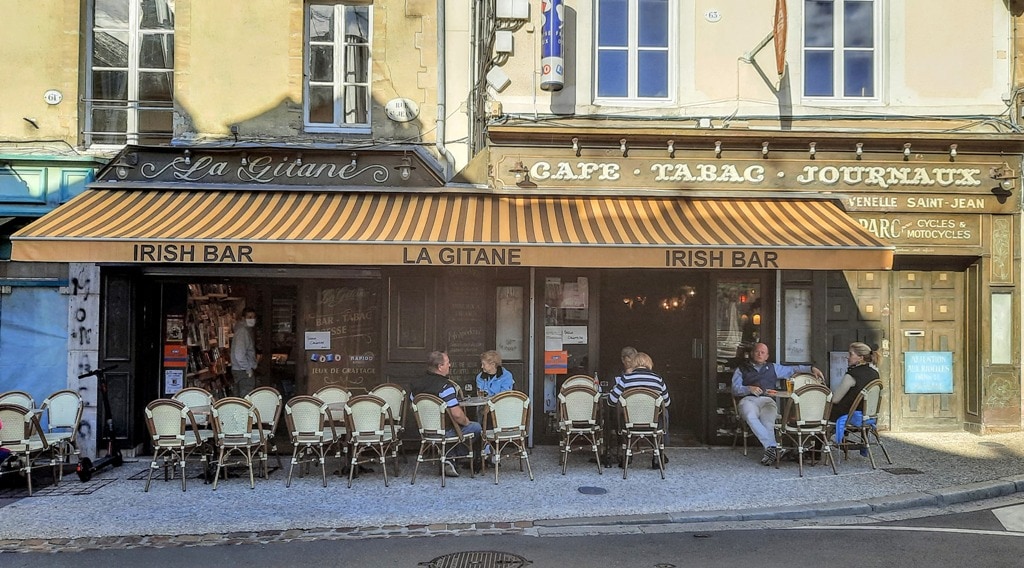
D Day Beaches and Museums from Bayeux
Bayeux is perfectly situated to tour the Normandy Beaches and WWII memorials from. You can take tours to these areas or simply drive yourself.
If you decide to go on your own you will definitely want to visit some of the following sites:
- Airborne Museum, Caen Museum, and Juno Beach Centre to name a few
- American Cemetery, Bény-sur-Mer Canadian War Cemetery, Bayeux War Cemetary and many others
- Utah Beach, Juno Beach, Omaha Beach, Sword Beach and Gold Beach
- Sainte Mere Eglise Church
- Pegasus Bridge Memorial
Where to eat in Bayeux, France
La Reine Mathilde
I highly recommend La Reine Mathilde (Queen Matilda) shop for afternoon tea the shop is named after Reine Mathilde, who was William the Conqueror’s wife. The shop is absolutely lovely and is decorated in 1800s style with chandeliers, antique wrought iron garden furniture and white walls. Don’t bother with the coffee as usual in France it is not so good but there is a great selection of teas and the pastries simply can’t be beaten.
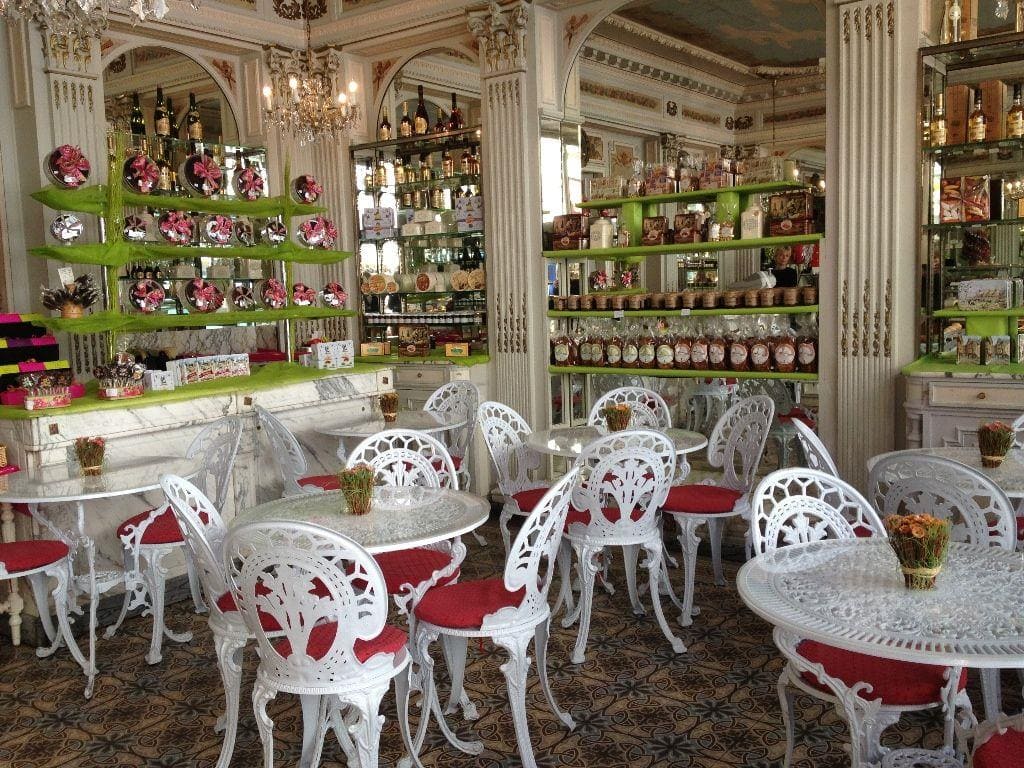
La Rapière
La Rapière is located on a small ancient lane just off the main street of rue St Martin on rue St Jean in the heart of the city of Bayeux. The restaurant is within a natural stone room dating from the 16th century. Linda and Simon who own the restaurant speak English as do all their staff and the food is absolutely superb. The menus are fixed prices and range from lunch menus €16-21, dinner menus €36-49, and mains €20-28.
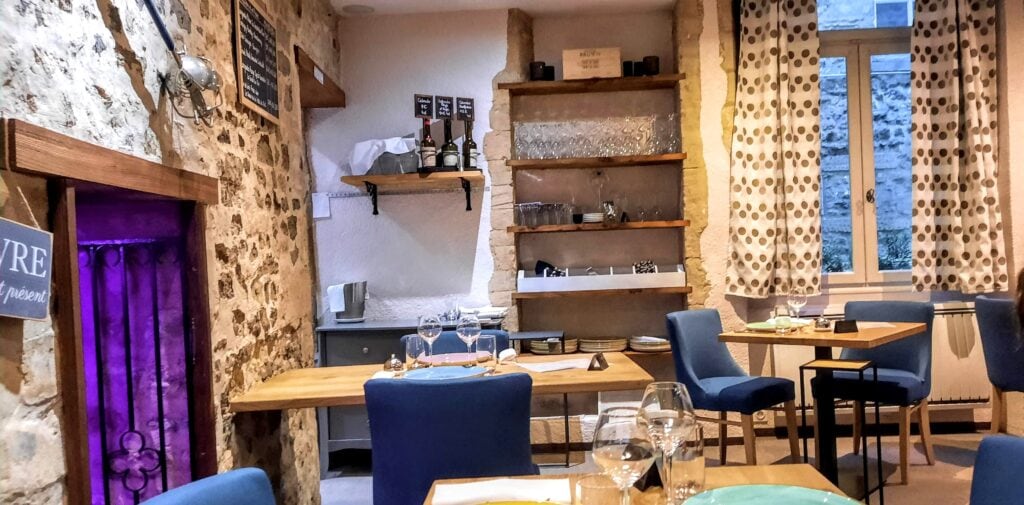
We had a lobster ravioli starter, followed by a melt-in-your-mouth roast pork loin served with dried apple and the silkiest mashed potatoes I’ve ever eaten.

Hubs had a steak with mash potato beautiful seasonal vegetables and chanterelle mushrooms.

Desert well let’s just say we ate superbly and did manage to fit in our beautiful deserts of chestnut cheesecake and salted caramel and chocolate. Everything was so good and so well-priced we ate here twice.
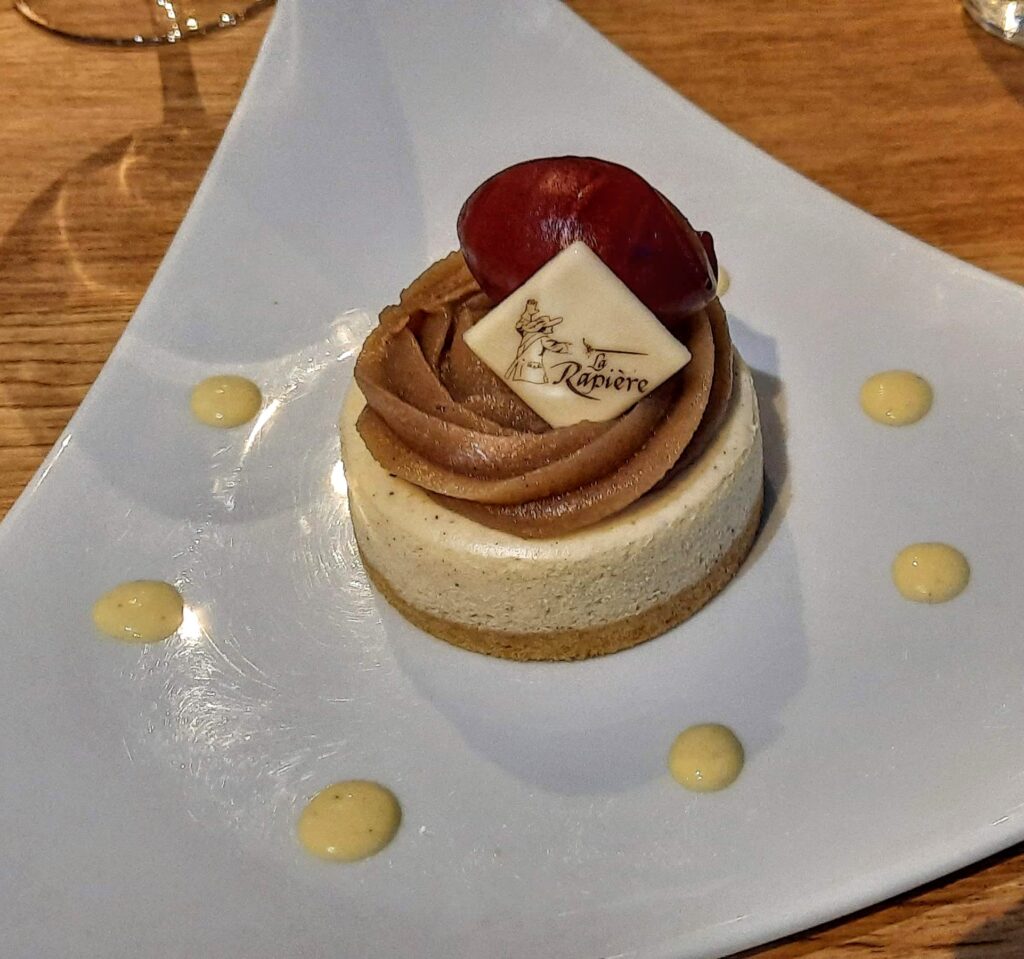
Au Ptit Bistrot
The Ptit Bistro was just around the corner from our accommodation. It’s unassuming looking but has a cute patio. However, the food is fabulous from braised beef cheeks with red wine to roasted pigeon you will be delighted if you get a reservation here.
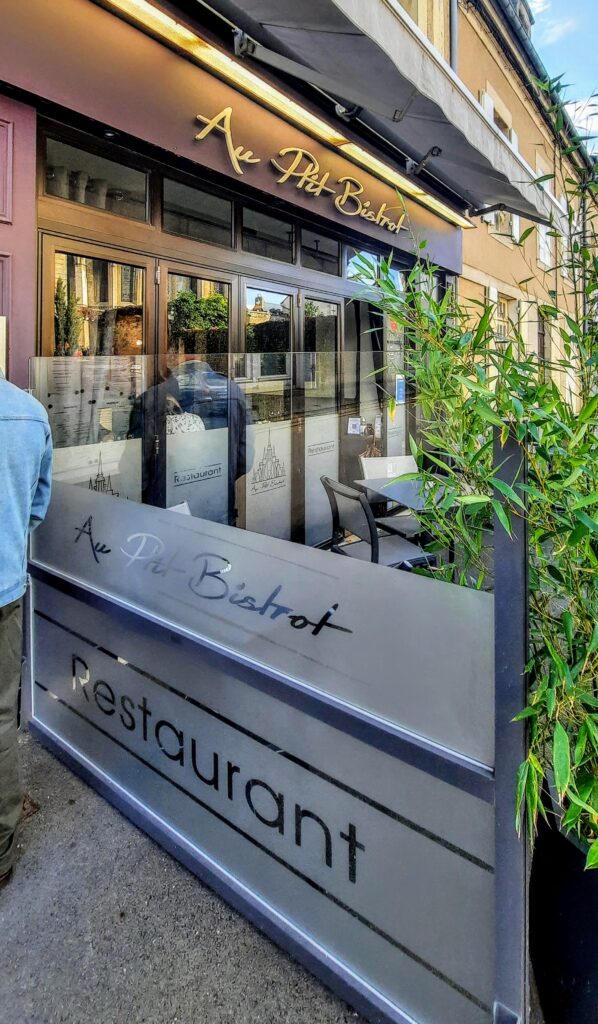
Les Volets Roses
If you are touring the Cathedral on your way to the front entrance you will find Les Volets Roses which is another lovely tea room to take a rest at. This little café even serves a French breakfast of coffee, orange juice, croissant, bread, butter and confiture. Rarely in France can you find a café or restaurant open on a Sunday but here they have a brunch which includes fantastic French cheese, quiche, bread, cakes and tarts which is all delicious.
Where to stay in Bayeux, France
The Tiny House
We stayed at the absolutely stunning Tiny House au Coeur de Bayeux. It was set within yards of the Cathedral and a very short walk to the main street of Bayeux and it was fantastic. The house is not so tiny and we had more space than the house we are currently housesitting in.
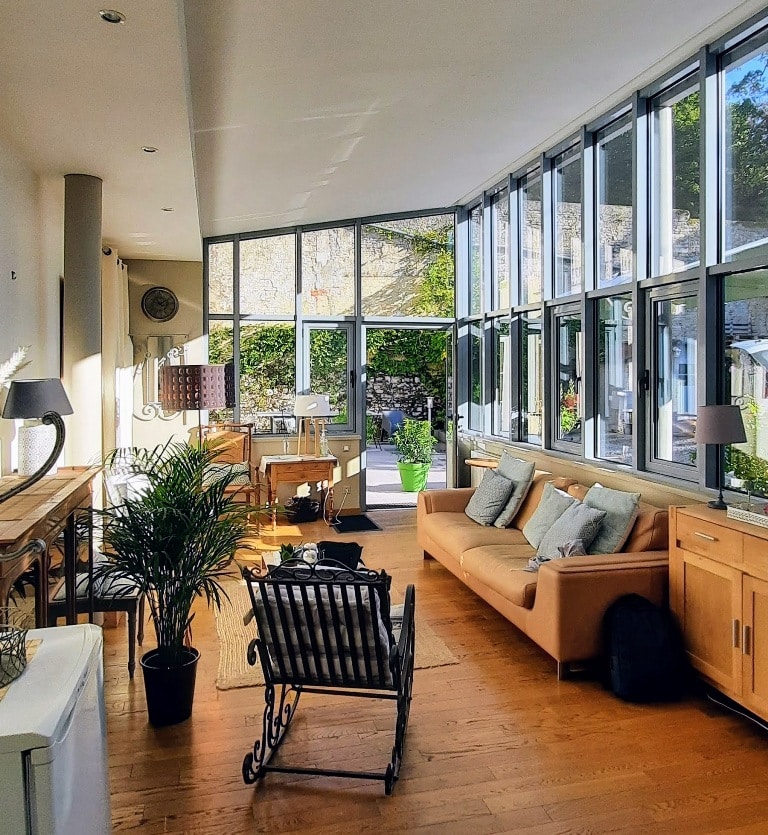
There was a gorgeous outdoor space and garden to enjoy. The house itself is beautifully equipped with a separate bedroom, a lovely modern bathroom off the bedroom and a good-sized open-plan living, and dining kitchen area. We could not have asked for better.
Offering free WiFi and city views, Au cœur du centre historique is an accommodation located in Bayeux, just less than 1 km from Cathedrale Notre Dame de Bayeux and a 10-minute walk from Baron Gerard Museum.
This apartment comes with 1 bedroom, a kitchen with a microwave and a fridge, a flat-screen TV, a seating area and 1 bathroom. Towels and bed linen are featured in the apartment.
The Hotel Reine Mathilde
Hotel Reine Mathilde is situated in the medieval district, just 300 m from the Bayeux Tapestry Museum. It offers free Wi-Fi access and modern guest rooms with private bathrooms.
The guest rooms are decorated in warm, neutral colours. Each has a TV and a work desk. The private bathroom provides a hairdryer.
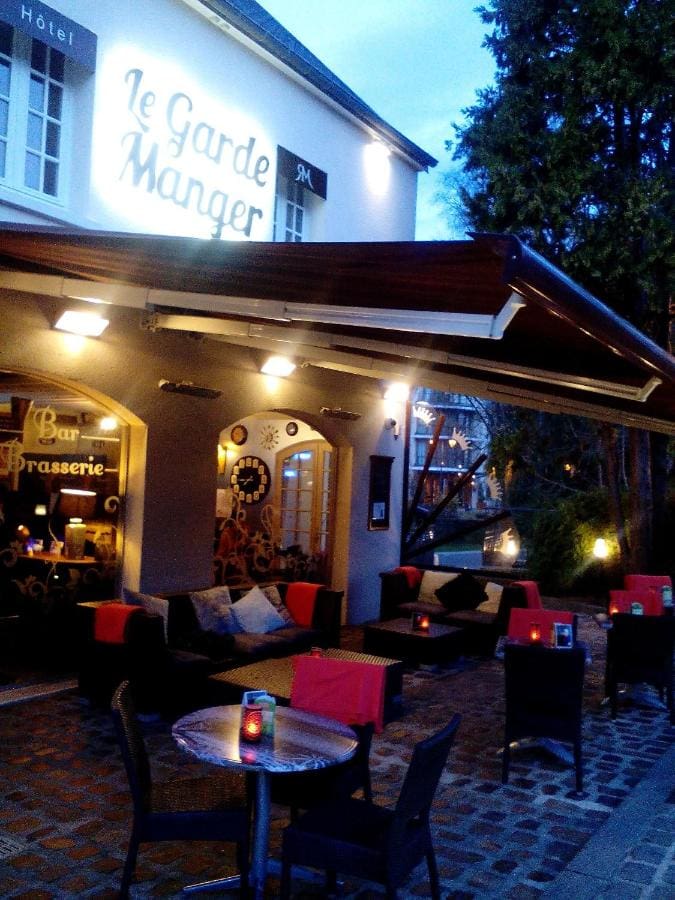
A buffet breakfast is served daily. The restaurant, Le Garde Manger, offers continuous service throughout the day. Guests can enjoy a varied selection of traditional dishes in the dining room or on the south-facing terrace.
Château de Bellefontaine
The Château de Bellefontaine is located 800 m from central Bayeux and its cathedral, this 18th-century mansion offers guest rooms and a traditional restaurant open for dinner upon reservation. The park has a tennis court and a pond and is planted with 200-year-old trees.
Each room is individually decorated and features a minibar, free WiFi access and a flat-screen TV. The bathrooms include a hairdryer, free toiletries and a bath or a shower. Some rooms have a seating area.

Enjoy a buffet breakfast every morning at the Château de Bellefontaine. A continental breakfast can also be delivered to your room at a reduced rate. After breakfast, you can use the computer with internet access in the lounge, which also features a fireplace.
There you have it – I could have stayed in Bayeux France and dare I say it even lived in or near this lovely town. How about you have you made it to see the Bayeux Tapestry or visited the town?
Interested in reading more about visiting France? Here are some more articles for you.
Beautiful villages in Normandy
Visiting Mont St Michel the ultimate guide to this UNESCO site
Dinan France – medieval France at its finest
The Ultimate guide to visiting Rennes France
Food in Brittany: Fall in love with the food of Bretagne
Castles of the Loire Valley France



